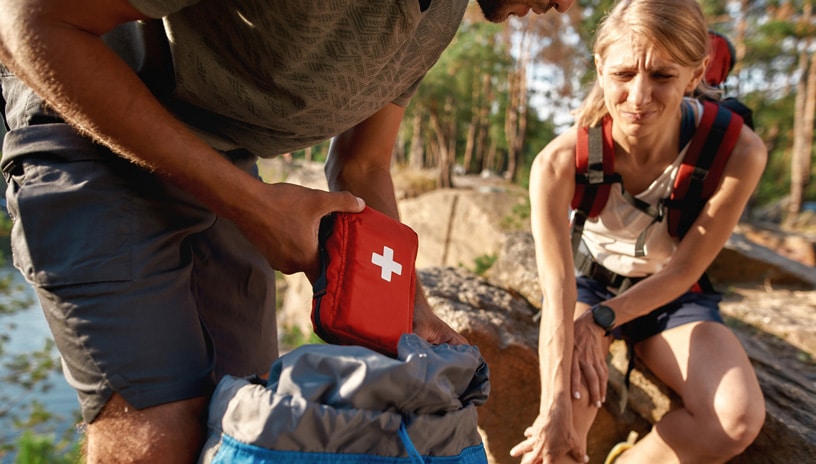First Aid Basics for Summer Activities

How to Handle Bites, Burns, Sprains, and More While Enjoying the Outdoors
Prepare for Summer Activities
The arrival of summer is an exciting time. Most of us look forward to summer holidays, the opportunity to enjoy the sunshine and fun summer activities. However, many of our summer activities also increase our risk of injuries and unexpected events.
Here are a few basic insights from trusted sources to help you prepare and respond to common warm-weather mishaps.
#1. Insect Bites and Stings
From mosquitoes and ticks to wasps and bees, insect bites are a common summer nuisance that can become a serious issue. Best prevention: Wear repellent and use other protective measures to reduce your risk of bites.
What to do:
Mosquito bites: Wash the affected area. Apply an anti-itch cream or a cold compress to help reduce swelling and itching.
Bee stings: If the stinger is visible, gently scrape it away with a credit card or other dull, clean object (don’t squeeze it). Clean the area and apply ice to reduce pain.
Tick Bites: Use fine-tipped tweezers to grasp the tick as close to the skin’s surface as possible. Pull upward steadily and clean the area thoroughly.
When to seek help:
Call 911 immediately if a person shows signs of an allergic reaction (such as swelling of the face or lips, difficulty breathing, or dizziness). Additionally, watch for symptoms of flu-like symptoms of illness in the coming weeks.
If the person experiences these symptoms, contact your healthcare provider and report the previous mosquito or tick bite for further evaluation.
#2. Sunburn Relief
Even short periods of unprotected sun exposure can lead to painful sunburns. Best prevention: Wear a protective hat and clothing and use sunscreen with a SPF of 30 or higher.
What to do:
- Move to the shade or indoors immediately.
- Take a cool (not cold) shower or apply a damp cloth to affected areas.
- Apply aloe vera or over-the-counter hydrocortisone cream to reduce inflammation.
- Drink plenty of water to prevent dehydration.
#3. Minor Cuts and Scrapes
Outdoor fun sometimes leads to tumbles, especially for kids. Best prevention: Wear protective clothing and appropriate gear for activities where injuries may be more likely.
What to do:
- Wash your hands and clean the wound with mild soap and water.
- Apply antibiotic or other protective ointment.
- Keep the area clean and protected from further injury while it heals.
- If necessary, cover with a clean bandage and change it daily or sooner if it gets wet or dirty.
- Watch for infection.
Contact your healthcare provider if the area becomes red, swollen, or starts to drain pus. Additionally, a tetanus vaccine may be necessary if you haven't received one in the past five years and the wound is deep or contaminated.
#4. Sprains and Strains
Whether it’s from a misstep on a trail or a fall off a bike, joint injuries can quickly ruin a summer outing. If you sustain a joint injury that results in swelling, bruising, pain, or limited movement, seek medical attention to ensure proper diagnosis and treatment.
What to do in the meantime (R.I.C.E. method):
- Rest: Stop using the injured limb.
- Ice: Apply an ice pack (wrapped in cloth) or a cold compress for 15–20 minutes at a time
- Compression: Proper use of an elastic wrap or sleeve can reduce swelling.
- Elevation: Raise the injured area above heart level frequently throughout the day.
Be Prepared Before You Go
Every household and summer travel bag should include a well-stocked first aid kit. Essentials include:
- Bandages in various sizes
- Antiseptic wipes and ointment
- Tweezers and small scissors
- Cold packs
- Sunscreen and bug spray
- Hydrocortisone cream
- Pain relievers (acetaminophen or ibuprofen)
- Instant cold compress
- Allergy medications (like antihistamines)
Additional First Aid Information
Basic first aid knowledge is an invaluable resource in managing unexpected injuries. Organizations such as the American Red Cross and the American Heart Association offer First Aid and CPR classes for the public.
The Moultrie County Health Department is here to support your health and safety needs. Whether you have questions about first aid training, need information on health services, or would like to learn more about our programs, we're here to assist you.

